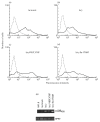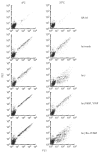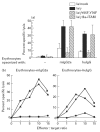FcgammaRIa-gamma-chain complexes trigger antibody-dependent cell-mediated cytotoxicity (ADCC) in CD5+ B cell/macrophage IIA1.6 cells
- PMID: 9737671
- PMCID: PMC1905059
- DOI: 10.1046/j.1365-2249.1998.00666.x
FcgammaRIa-gamma-chain complexes trigger antibody-dependent cell-mediated cytotoxicity (ADCC) in CD5+ B cell/macrophage IIA1.6 cells
Abstract
Most receptors for immunoglobulins exist as multi-subunit complexes, with unique ligand binding alpha-chains, combined with accessory signalling (gamma-, beta-, or zeta-) chains. The myeloid class I receptor for IgG (FcgammaRIa) has been shown to be dependent on the FcR gamma-chain for surface expression in vivo. In this study we assess the capacity of FcgammaRIa-gamma-chain complexes expressed in IIA1.6 cells to trigger phagocytosis and ADCC. An intact immunoreceptor tyrosine-based activation motif (ITAM) signalling motif proved essential for triggering of biological function via the FcgammaRIa receptor complex. Both the FcR gamma-chain and the FcgammaRIIa-ITAM proved active in directing phagocytosis of Staphylococcus aureus and ADCC of erythrocytes, triggered by the FcgammaRIa complex. The capacity of FcgammaRIa to trigger phagocytic and cytolytic activity by IIA1.6 cells, both considered 'professional phagocyte' functions, motivated us to re-evaluate the cell lineage and developmental stage of IIA1.6 cells. Although originally described as mouse B lymphocytes, the IIA1.6 cells proved positive for non-specific esterase activity and expressed the CD5 antigen. These combined characteristics place the IIA1.6 cells within a unique CD5+ B cell/macrophage lineage, optimally suited for cell biological analyses of phagocyte receptors.
Figures





Similar articles
-
The FcgammaRIa (CD64) ligand binding chain triggers major histocompatibility complex class II antigen presentation independently of its associated FcR gamma-chain.Blood. 1999 Jul 15;94(2):808-17. Blood. 1999. PMID: 10397749
-
Differential enhancement of dengue virus immune complex infectivity mediated by signaling-competent and signaling-incompetent human Fcgamma RIA (CD64) or FcgammaRIIA (CD32).J Virol. 2006 Oct;80(20):10128-38. doi: 10.1128/JVI.00792-06. J Virol. 2006. PMID: 17005690 Free PMC article.
-
Antibody-mediated erythrolysis and erythrophagocytosis by human monocytes, macrophages and activated macrophages. Evidence for distinction between involvement of high-affinity and low-affinity receptors for IgG by using different erythroid target cells.Immunology. 1988 Mar;63(3):513-20. Immunology. 1988. PMID: 2965100 Free PMC article.
-
Intracytoplasmic sequences involved in the biological properties of low-affinity receptors for IgG expressed by murine macrophages.Braz J Med Biol Res. 1995 Mar;28(3):263-74. Braz J Med Biol Res. 1995. PMID: 8520518 Review.
-
Macrophages are critical effectors of antibody therapies for cancer.MAbs. 2015;7(2):303-10. doi: 10.1080/19420862.2015.1011450. MAbs. 2015. PMID: 25667985 Free PMC article. Review.
Cited by
-
Turning the tables on cytomegalovirus: targeting viral Fc receptors by CARs containing mutated CH2-CH3 IgG spacer domains.J Transl Med. 2018 Feb 8;16(1):26. doi: 10.1186/s12967-018-1394-x. J Transl Med. 2018. PMID: 29422056 Free PMC article.
-
IgA Targeting Human Immunodeficiency Virus-1 Envelope gp41 Triggers Antibody-Dependent Cellular Cytotoxicity Cross-Clade and Cooperates with gp41-Specific IgG to Increase Cell Lysis.Front Immunol. 2018 Mar 29;9:244. doi: 10.3389/fimmu.2018.00244. eCollection 2018. Front Immunol. 2018. PMID: 29651286 Free PMC article.
-
The conundrum between immunological memory to adenovirus and their use as vectors in clinical gene therapy.Mol Biotechnol. 2006 Oct;34(2):247-56. doi: 10.1385/MB:34:2:247. Mol Biotechnol. 2006. PMID: 17172670 Review.
-
Depletion of synovial macrophages in rheumatoid arthritis by an anti-FcgammaRI-calicheamicin immunoconjugate.Ann Rheum Dis. 2005 Jun;64(6):865-70. doi: 10.1136/ard.2004.028845. Epub 2004 Nov 11. Ann Rheum Dis. 2005. PMID: 15539412 Free PMC article.
-
Direct interaction between FcgammaRI (CD64) and periplakin controls receptor endocytosis and ligand binding capacity.Proc Natl Acad Sci U S A. 2004 Jul 13;101(28):10392-7. doi: 10.1073/pnas.0401217101. Epub 2004 Jun 30. Proc Natl Acad Sci U S A. 2004. PMID: 15229321 Free PMC article.
References
-
- Van de Winkel JGJ, Capel PJA. In: Human IgG Fc receptors. Austin Texas, Landes R.G., editors. 1996.
-
- Hibbs ML, Selvaraj P, Carpen O, Springer TA, Kuster H, Jouvin M-H, Kinet J-P. Mechanisms for regulating expression of membrane isoforms of FcγRIII (CD16) Science. 1989;246:1608–11. - PubMed
-
- Blank U, Ra C, Miller L, White K, Metger H, Kinet J-P. Complete structure and expression in transfected cells of high affinity IgE receptor. Nature. 1989;337:187–9. - PubMed
-
- Van Vugt MJ, Heijnen Iafm, Capel PJA, Park SY, Ra C, Saito T, Verbeek JS, Van de Winkel JGJ. FcR γ-chain is essential for both surface expression and function of human FcγRI (CD64) in vivo. Blood. 1996;87:3593–9. - PubMed
-
- Isashi Y, Yamashita T, Nagasawa S, Murakami M, Uede T. Molecular cloning and characterization of guinea pig FcγRIII: expression but not function is independent of the γ chain of FcɛRI. Int Immunol. 1996;8:1335–46. - PubMed
Publication types
MeSH terms
Substances
LinkOut - more resources
Full Text Sources

